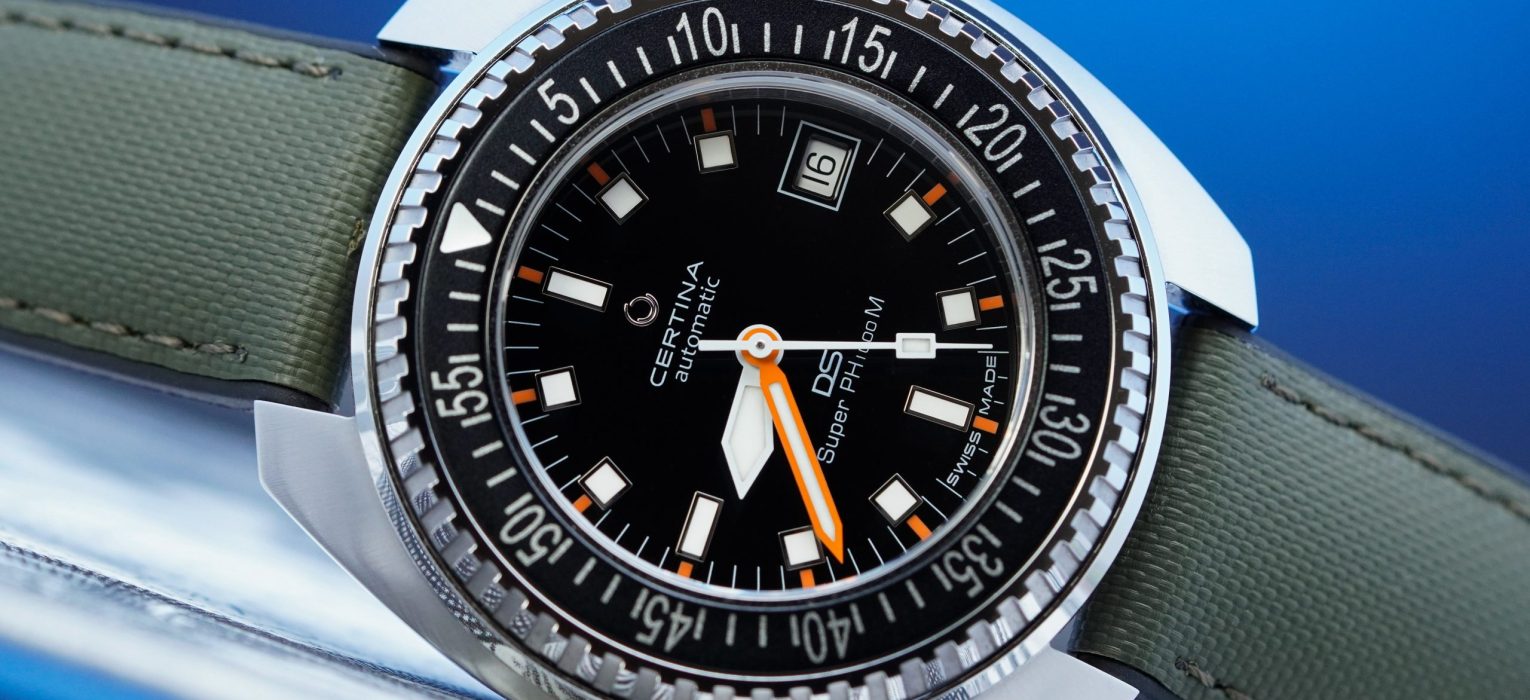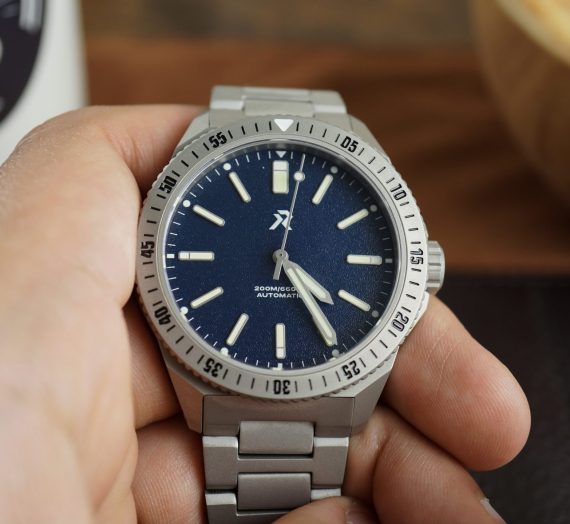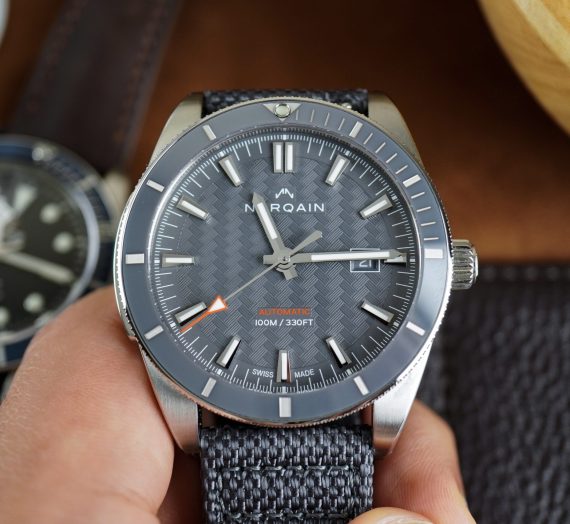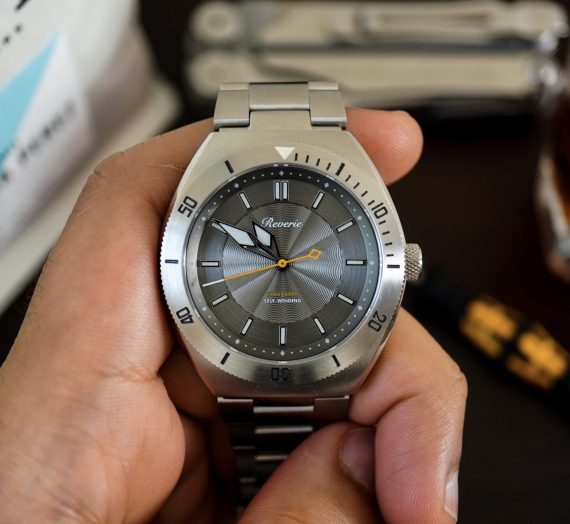Disclaimer: this video/review was not sponsored by Certina or any other entity.
Video
Review
Admittedly, I had not given Certina the attention it deserved, dismissing it as just another player among the vast sea of large conglomerate Swiss brands commonly seen lining mall displays. However, getting to experience and learn about the Certina DS Super PH1000M has revealed a depth to this brand that I had previously (and ignorantly) overlooked. With a rich history dating back to its founding in 1888 by Adolf and Alfred Kurth in Grenchen, Certina has evolved significantly from its humble beginnings with three employees in a small workshop. By joining the General Watch Co (ASUAG) in 1971 as part of a strategic move during the Quartz Crisis, Certina solidified its commitment to innovation, especially noted in 1959 when Hans and Edwin Kurth developed the “Double Security” (DS) concept, enhancing shock protection and water resistance in ways that were ahead of their time. Today, Certina belongs to the behemoth that is the Swatch Group, and they are able to leverage some of the technology and manufacturing skills of their parent group to deliver very capable watches.
It significantly enhanced the robustness of watches by increasing shock protection and boosting water resistance to 6 meters, a substantial improvement over the previous standard of 2.2 meters. This technological advance was not just theoretical; it was is rumored to have been practically tested in extreme conditions – it was put to the test during a high-altitude expedition in the Himalayas. The watches equipped with this technology accompanied a climbing team to Dhaulagiri, one of the highest peaks in the world.
The DS Super PH1000M, introduced in the 1970s offered up to 1000 meters of water resistance – a remarkable feat for its era, and still quite impressive even today. The modern resurgence of vintage-styled dive watches has prompted Certina to revisit and reissue this iconic model, blending classic aesthetics with modern technology and materials. This watch is currently offered in three variants including the black dial version I’m reviewing, maintain the original’s robust charm while integrating contemporary enhancements like improved automatic movements and sapphire crystals. Priced at 915 CHF ($940 USD through US distributors like Teddy Baldassarre), and potentially less at discount retailers like Macys, the DS Super PH1000M is a surprisingly impressive diver that packs a serious punch for its price.
Let’s check it out!
Case
The DS Super PH1000M showcases a meticulously designed case that stands out to me as one of the more impressive dive watch designs. Measuring 43.3mm in diameter, 47.3mm lug-to-lug, and 14.20mm in height with a 20mm lug width, the case not only presents robust dimensions but also excels in ergonomic design and aesthetic appeal. The combination of brushed, blasted, and polished finishes across the case surface highlights the watch’s dynamic contours and complex craftsmanship. Particularly impressive is the tapering design of the entire case, from mid case through the bezel, which narrows from 39.5mm to 37.5mm, framed by a polished ring that adds a subtle elegance to its robust functionality and teases the innovative bezel operation mechanism we’ll discuss soon.

The case’s side profile is gracefully rounded towards the wrist, featuring polished sides and a brushed top, enhancing both comfort and visual depth. The lugs extend with a gentle curve, seamlessly integrating with the fluid design of the mid-case which contributes significantly to the watch’s perceived slenderness. The bezel introduces an innovative operational twist; it is a 120-click unidirectional dive bezel that requires pressing down to activate, adding an extra layer of security albeit with a slight increase in operational complexity. Once pressed down, the bezel operates like a regular dive bezel, although slightly more glitchy since the bezel requires an even application of pressure while twisting it, and also requires that the bezel line up to one of 120 clicks before releasing it.

The aluminum bezel insert remains faithful to the original design, featuring a lumed triangle at the 12 o’clock position for improved readability in low light conditions. On the case’s left side, a helium release valve is discreetly integrated, tucked into the polished mid-case, while the opposite side houses a 5.3mm screw-down crown adorned with the brand’s logo, offering easy and reliable operation. Despite its robust size, the case’s clever design elements like the recessed crown and valve contribute to a more compact feel on the wrist.

Flipping the watch reveals a solid screw-down case-back, detailed with text and artwork, which, while adding to the overall thickness, is designed to sit comfortably against the wrist, disguising its bulk effectively. This watch’s case design is extremely impressive, but also incorporates functional features like 1000m water resistance. Overall, I’m a huge fan of what Certina has been able to deliver with the design and engineering of this watch, and it might just be one of the more impressive dive watch cases I’ve handled over the years.
Dial
The DS Super PH1000M features a dial that manages to capture the essence of a tool watch, offering exceptional legibility and a straightforward layout that resonates with its strong design DNA. The base of the dial is a glossy black, likely achieved through painting or lacquering, providing a rich backdrop for the dial elements.

The minute track around the outer rim is marked by slim white ticks for each minute, with orange rectangles highlighting every five-minute increment, enhancing both the aesthetic and functionality of the display. Hour markers are represented by square and rectangular indices, applied with precision and generously filled with BGW9 Super LumiNova, ensuring excellent visibility in low light conditions. The indices are well-finished, contributing to the dial’s overall sharp appearance. At the 3 o’clock position, you have a date window that includes a printed white border that integrates seamlessly with the rest of the design.


The brand’s logo and name are tastefully applied below the 12 o’clock index, with the somewhat long and unnecessary watch name printed above the 6 o’clock position, all exhibiting good print quality without any noticeable smudges or defects.


The handset of the DS Super PH1000M is particularly appealing to me, featuring a large broadsword-style hour hand in white with ample lume, paired with a more conventional orange-painted minute hand, also lumed for visibility. The seconds hand, in white, includes a small lumed rectangular segment.

While the overall design remains faithful to the original and avoids unnecessary creative liberties, my examination under a loupe and macro lens revealed some minor quality control issues, such as stray dust and paint particles. These imperfections are not visible to the naked eye but might be a point of contention for enthusiasts who appreciate flawless execution. Nonetheless, the Certina DS Super PH1000M’s dial is well-executed, sticking true to its heritage and providing a familiar and visually pleasing design aesthetic.
Lume
The PH1000M does great in the luminosity department, catering well to the demands of lume junkies such as myself. The watch features applied hour indices and hands generously filled with BGW9 or an equivalent lume, ensuring strong initial brightness and excellent longevity. The bezel’s lume application is limited to the triangle marker only, but this does not detract from the overall effectiveness of the luminescence.

In my video, I include a 20-minute time-lapse to compare the lume performance of the Certina with several other well-regarded dive watches including the Synchron Poseidon Ice Diver, Tudor Black Bay Monochrome, Seiko Samurai SRPL13, Christopher Ward C60 Bronze, and CWC Royal Navy 300. The Certina DS Super PH1000M stood out as one of the top performers, glowing brightly initially and persistently throughout the duration of the test.

Movement
The Certina is equipped with the Powermatic 80.611 movement, a member of the somewhat opaque Powermatic 80 series. This movement is a collaborative effort between the Swatch Group and its movement manufacturing subsidiary, ETA. Originating from the reliable ETA 2824-2 design, the Powermatic 80 series was launched around 2011-2012 with the aim of boosting power reserve and overall efficiency. This enhanced design is now a staple in timepieces from various Swatch Group brands such as Tissot, Certina, and Hamilton.
A standout feature of the Powermatic 80.611 is its impressive 80-hour power reserve, which far surpasses the typical 38-42 hours offered by many other movements. This extended power is made possible by reducing the beat rate from 4Hz to 3Hz and integrating a redesigned mainspring. Additionally, this movement is fitted with a Nivachron balance spring and a Novodiac shock protection system, enhancing its durability and resistance to magnetic fields. While specific accuracy ranges for the Powermatic 80.611 are not explicitly stated, my personal experience has shown it to perform reliably, with daily deviations remaining in the single digits when the movement is fully wound.
On The Wrist
The PH1000M, with its 43.3mm diameter and 47.3mm lug-to-lug measurement, initially suggests a larger watch that might overwhelm my 6.75″ wrist. However, its design cleverly ensures a comfortable fit that respects the limits of my wrist span. The distribution of the 43.3mm diameter is particularly well-executed, allowing the watch to sit balanced and poised on the wrist. Despite its 14.20mm thickness, the watch manages to look deceivingly slim – a stark contrast to the Synchron Poseidon Ice Diver that I recently reviewed, which at 14.5mm feels at least 1-2mm taller, and significantly bulkier.


The nylon strap provided with the watch, while functional, tends to accentuate its size and thickness somewhat unfavorably. Switching to a thicker, more substantial strap like the Artem HydroFlex, as shown in some accompanying photos, brings a better balance, complementing the watch’s profile and enhancing overall wear-ability. A significant portion of its height is integrated into the curved and protruding caseback, which surprisingly doesn’t add to a top-heavy feel but instead contributes to its stability on the wrist.
In essence, the Certina DS Super PH1000M wears more like a 42mm watch rather than its actual 43.5mm size, thanks to its thoughtful design. If your wrist can accommodate the 47.3mm lug-to-lug span, this watch will likely feel right at home, making it a great option for those seeking a large yet comfortably wearable dive watch. Similar to what I said in my review of the Poseidon Ice Diver, I can’t help but think that this watch would benefit heavily from a well integrated bracelet with well articulating end links.
Wrapping Up
The DS Super PH1000M brings a lot to the table, combining great heritage and solid performance features with a reasonable price point. Its terrific case design, an unusual and innovative bezel mechanism, a robust movement, and substantial water resistance are certainly worthy of praise. For a watch in this price range, it offers functionalities and a legacy that are hard to find, particularly among larger conglomerate brands – a sector I am usually skeptical about, often favoring micro-brands for their unique offerings, attention to detail, and overall better pricing.
However, the PH1000M is not without some shortcomings. The quality control on the dial could be improved, as there is noticeable stray paint and dust particles when viewed under a macro lens, which might detract from its appeal to more obsessive enthusiasts such as myself. Additionally, the press-and-twist uni-directional dive bezel, while a clever feature, can be tricky to operate smoothly if you don’t offer consistent pressure, occasionally leading to jamming. Also, despite its well-executed design, the watch’s size may still pose a challenge for those with smaller wrists, limiting its versatility and wear-ability across different users.




